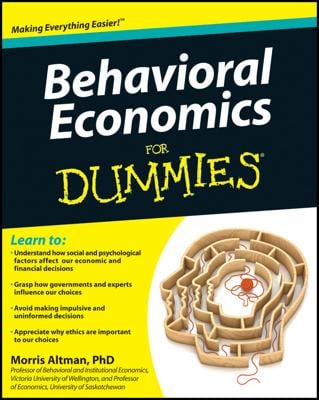Understanding consumer behavior helps you in determining how to influence it. After all, your goal is to maximize profits, but to do that, you have to have customers purchase your product. Consumers make decisions based upon satisfaction/utility and price.
Although you can influence satisfaction through things like advertising, you have complete control over price. Thus, how you price your product influences how much customers purchase, because changing the good’s price changes the customer’s budget constraint.
Buy-one-get-one-free specials
One common pricing strategy is to offer customers who buy one unit of your product a second unit free. You don’t know whether customers will buy one unit. The purpose of this pricing strategy is to get more customers to purchase the first unit.
The increase in the number of customers who buy the first unit occurs because this pricing strategy changes the slope of the budget constraint. Consider the situation where a customer is deciding where to go for lunch — the taco stand or your pizza restaurant. The taco stand sells tacos for $0.50 each while you sell pizza at $1.00 per slice. The customer plans to spend up to $3.00.
| Same Price Every Unit | Buy One, Get One Free | ||
|---|---|---|---|
| Number of Pizza Slices | Number of Tacos | Number of Pizza Slices | Number of Tacos |
| 0 | 6 | 0 | 6 |
| 1 | 4 | 1 | 4 |
| 2 | 2 | 2 | 4 |
| 3 | 0 | 3 | 2 |
| 4 | 0 |
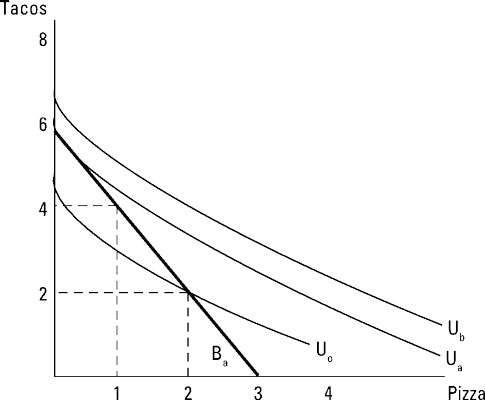
The customer’s goal is to maximize utility by going to the highest indifference curve touched by the budget constraint Ba. For the indifference curve map, the highest indifference curve touched by the budget constraint Ba is Ua, which indicates the customer buys six tacos and zero slices of pizza.
Now, you decide to offer a special promotion: buy one slice of pizza and your second slice is free. Now, if customers buy one slice of pizza, they can still buy four tacos. And because the second slice of pizza is free, the customers can still buy four tacos with two slices of pizza.
On the graph, this promotion has added a horizontal section to the budget constraint, shifting the budget constraint out at the point between one and two slices of pizza. (Remember, the second slice of pizza doesn’t cost customers anything.) The new budget constraint for the customer is Bb.
Again, your customers want to maximize utility by finding the highest indifference curve touched by the new budget constraint. This is the indifference curve Ub, and it indicates that the customers now buy four tacos and two slices of pizza. You’ve gone from selling no pizza to this customer to selling two slices! And as an added bonus, your customer is getting even more satisfaction than before.
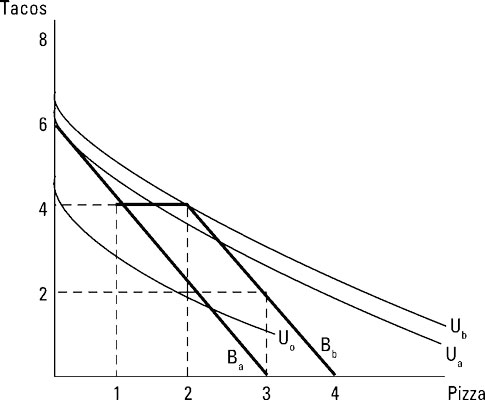
Gift cards
Gift cards are used to bias customers toward your business over a competitor. Because the customer can use the gift card at only your business, gift cards affect the shape of the budget constraint.
Compare a situation where a customer has $50 in cash versus $25 in cash and a $25 gift certificate to your store. At first, these situations may seem essentially the same — but they’re not. The gift certificate can be used at only your store, so the maximum that can be spent at your competitor is now only $25.
The illustration compares the two budget constraints. The budget constraint Ba is the budget constraint that exists if the customer can spend $50 cash at either your store or a competitor’s store. (Assume a price of $1 per unit for the good being purchased.) Given $50 cash, the customer maximizes utility on indifference curve Ua, spending $38 at your competitor’s store and $12 at your store.
If the customer has a $25 gift certificate at your store, the maximum he can spend at the competitor’s store is $25, while he can spend a maximum of $50 at your store ($25 cash plus $25 gift certificate). The new budget constraint is Bb. Now the customer maximizes utility with indifference curve Ub, spending $25 at your competitor’s store and $25 at your store, $13 more than otherwise.
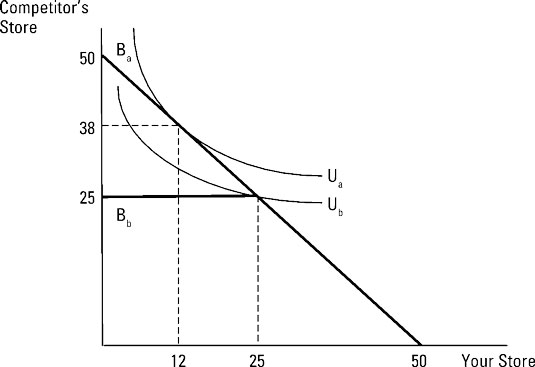
Coupons
As with gift cards, businesses use coupons to bias customers toward buying a particular good or from a specific business. By giving customers a discount, you effectively lower the product’s price. An added advantage of coupons is that they allow you to differentiate between consumers with different price elasticities of demand.
Back to your pizza restaurant, where you decide to run a special — $0.25 off each pizza slice with coupon.
Before the coupon, your customers were deciding between tacos priced at $0.50 each and pizza priced at $1.00 per slice. The customer had $3.00 to spend. The budget constraint for this situation is described by Ba. In this situation, the customer maximizes utility by purchasing four tacos and one slice of pizza — the point where the indifference curve Ua is tangent to the budget constraint Ba.
If you now offer $0.25 off per slice of pizza, the effective price is $0.75 per slice. Now the customer can buy up to four slices of pizza. The new budget constraint is Bb. The pivot in the budget constraint reflects the lower after-coupon price of a pizza slice.
As a result, the customer now purchases three tacos and two slices of pizza — the point where the indifference curve Ub is tangent to the new budget constraint Bb.
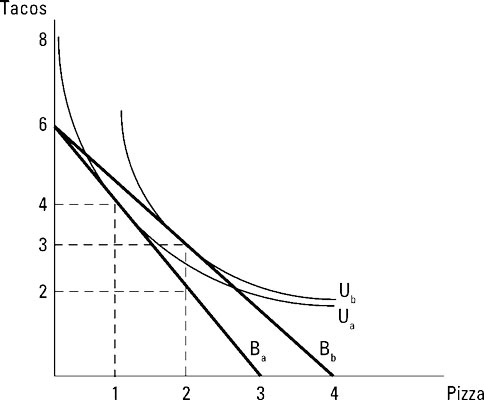
As these examples indicate, understanding consumer theory gives you multiple options on pricing strategies that increase your sales.

